#low-code development
Explore tagged Tumblr posts
Text
6 Things That You Need in Your Sales CRM
6 Things That You Need in Your Sales CRM
Choosing the right Sales CRM is crucial for boosting your sales process, improving customer relationships, and optimizing team productivity. However, with the rise of digital transformation, the integration of low-code and no-code platforms in CRM solutions has revolutionized how businesses tailor their tools. Below are six essential features that every best sales CRM should offer.
1. Seamless Integration with Other Tools
A top-tier CRM needs to integrate smoothly with other business tools, such as email marketing platforms, calendars, and social media management tools. This allows your team to streamline operations and centralize customer data in one place. For businesses looking to integrate additional features quickly, low-code application development can provide flexibility in connecting different tools without requiring extensive coding knowledge. Learn more about how low-code software can simplify integrations in your CRM
2. Customizable Dashboard
Every business is unique, and your CRM dashboard should reflect that. With a customizable dashboard, your team can view the metrics that matter most to them, from lead tracking to sales reports. Low-code development allows you to personalize the CRM interface with minimal effort, ensuring that each user has an optimized experience. If you're looking for a CRM that allows customization at scale, consider leveraging low-code platforms for mobile app development to create mobile-optimized dashboards.
3. Automation for Lead Management
Automation is a game-changer when it comes to lead management. By automating repetitive tasks, such as sending follow-up emails or reminders, your sales reps can focus on building meaningful relationships with clients. With low-code application development, automating processes becomes much more accessible, reducing the reliance on technical teams and speeding up deployment. Want to learn how automation can improve your CRM's performance? Check out Amoga’s CRM.
4. Real-Time Data and Analytics
In the fast-paced world of sales, having access to real-time data is essential. A CRM solution should provide dynamic dashboards and analytics that give you an up-to-date view of your customer interactions, sales pipeline, and team performance. With the advent of low-code platforms, integrating advanced analytics features into your CRM has never been easier, enabling real-time updates and empowering your team to make data-driven decisions.
5. Mobile Accessibility
In today’s mobile-driven world, your sales team needs a CRM that works on-the-go. A mobile-optimized CRM ensures that your reps have access to key customer data anytime, anywhere. The rise of low-code platforms for mobile app development has made it easier for businesses to create tailored mobile apps that integrate seamlessly with their CRM, helping your team stay connected and efficient while out of the office.
6. Comprehensive Customer Support
A CRM that provides comprehensive customer support can make all the difference. Whether it's onboarding, troubleshooting, or advanced configurations, great support ensures that your team can maximize the CRM’s potential. Many low-code software solutions offer built-in support systems or simple configurations that minimize the need for extensive technical assistance, helping your team get the most out of their CRM quickly.
#low code no code platforms for mobile app development#low-code development#low code application developmet#low-code software
0 notes
Text
The Future of Cloud App Development: Unlocking Business Value
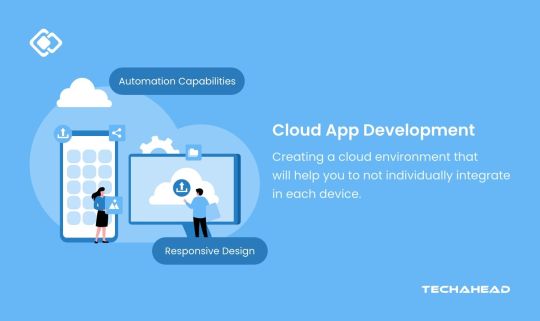
Cloud computing is rapidly transforming businesses. Many industry reports reveal that as business mobile applications grow, over 70% of digital workspaces face challenges with storage capacity and performance. The ideal solution to these issues is cloud app development, which provides unmatched scalability and flexibility.
Cloud app development simplifies data collection, enabling businesses to gather insights faster and more efficiently. It also enhances data security and streamlines management, making compliance and administration less burdensome. Cloud-powered development solutions empower businesses to create high-performance, productivity-focused applications that drive customer satisfaction and boost revenue.
Furthermore, cloud software solutions support low-code development, a time- and cost-efficient approach that minimizes extensive coding. This allows businesses to launch applications faster, optimizing resource usage and accelerating innovation cycles.
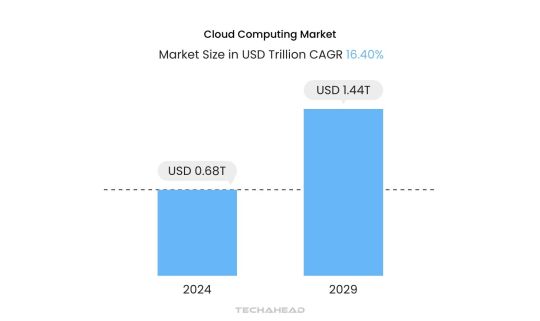
The cloud computing market is projected to grow substantially, with an estimated size of USD 0.68 trillion in 2024, anticipated to reach USD 1.44 trillion by 2029 at a CAGR of 16.40% (source: Mordor Intelligence). This robust growth highlights the rising demand for cloud solutions across industries. However, this rapid expansion in cloud applications prompts critical questions for businesses, especially around best practices in cloud app development.
In this guide, we’ll explore how to approach cloud app development effectively, the diverse cloud-based application solutions available, and how they drive value. You’ll gain insights into creating cloud applications that enhance operational efficiency, scalability, and customer engagement.
Let’s begin by examining the essentials that pave the way for efficient and future-ready cloud app development.
What is Cloud App Development?
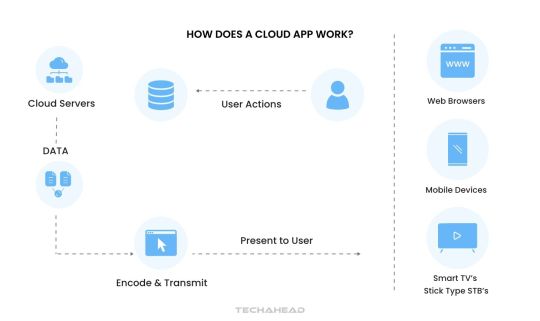
Cloud app development refers to creating applications within a cloud environment, bypassing the need for local servers. Unlike native applications, cloud-based apps rely extensively on cloud app development services, including data storage and processing, making them accessible through web browsers and other online platforms.
As enterprise development grows more reliant on cloud capabilities, they have leveraged its computational power to build groundbreaking solutions, transforming what’s possible in technology. Cloud services now empower companies to create a vast range of cloud applications that operate seamlessly on the web, often known as web apps.
These cloud apps are reshaping various business functions, taking over essential tasks like email, word processing, file storage, data collection, and even financial accounting. Through cloud app development, organizations are equipped with efficiency, streamline operations, and scale solutions like never before.
Types of Cloud App Development
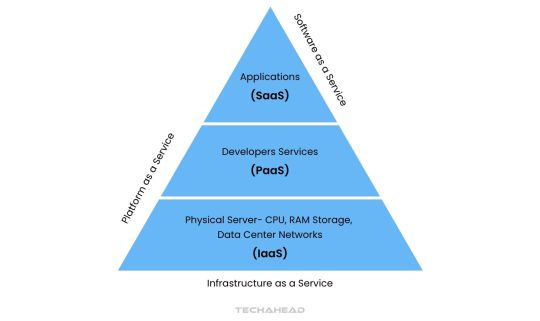
Software-as-a-Service (SaaS)
SaaS applications are hosted and maintained entirely by a cloud provider, making them accessible via the internet through web browsers. These applications relieve businesses from handling updates, server management, and software installations, as all maintenance is centrally managed by the provider. Users can seamlessly access features, integrate productivity tools, and share data across teams, which enhances operational efficiency.
Solutions like Google Workspace, Salesforce, and Slack exemplify SaaS by providing essential tools for collaboration, sales, and project management within a single, easily accessible platform.
Platform-as-a-Service (PaaS)
PaaS offers a managed environment for application development, which includes tools for building, testing, and deploying software while the cloud provider oversees infrastructure. By managing hardware and backend services, PaaS enables development teams to focus solely on cloud app development without the burden of configuring servers or databases. This platform accelerates time-to-market and streamlines scaling since the underlying resources are automatically adjusted as demand increases.
Examples like Microsoft Azure App Services and Google App Engine give developers robust frameworks and APIs, helping them build complex applications with minimal operational overhead.
Infrastructure-as-a-Service (IaaS)
IaaS delivers essential computing infrastructure such as virtual servers, storage, and networking resources. Unlike traditional on-premises infrastructure, IaaS allows businesses to pay for only the resources they use, which is ideal for scaling and managing large workloads flexibly. This model offers extensive control over the infrastructure, enabling IT teams to customize their environments and manage systems as needed.
Leading providers like AWS, Azure, and Google Cloud Platform provide services that allow companies to extend, scale, and secure their infrastructure easily, aligning with cloud app development needs for flexibility and resilience.
Function-as-a-Service (FaaS)
FaaS is part of serverless computing, allowing developers to deploy discrete code functions triggered by specific events, like user actions or system updates. With FaaS, there’s no need to manage or scale servers manually; the cloud provider handles it automatically based on demand. This model is ideal for applications requiring quick responses to high volumes of concurrent events, as it enhances cost efficiency and operational simplicity.
Popular FaaS services include AWS Lambda and Google Cloud Functions, which cater to cloud app development that prioritizes lightweight, highly scalable, and event-driven functionality.
Container-as-a-Service (CaaS)
CaaS leverages containers—lightweight, portable units of software that package application code along with its dependencies—for more efficient deployment and scaling across different environments. This model is highly beneficial for businesses adopting microservices architectures, as containers improve consistency in app deployment from development to production. CaaS platforms utilize orchestration tools, like Kubernetes, to automate the deployment, scaling, and management of containerized applications across multiple cloud or on-premises environments.
CaaS aligns with cloud app development demands for agility, allowing applications to scale seamlessly across hybrid or multi-cloud setups without compatibility issues.
Features of Every Cloud App Development Should Have
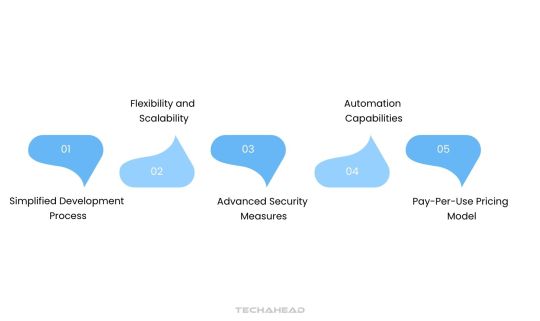
Simplified Development Process
An effective cloud app development platform should prioritize speed and simplicity. It should streamline architectural decisions, reducing complexity in creating and deploying applications across diverse technical environments. This simplicity allows hired developers to address challenges faster, minimizing errors and accelerating deployment. An efficient platform optimizes the overall development workflow, making it seamless to launch applications that meet high standards across various infrastructures.
Flexibility and Scalability
In cloud app development, flexibility is paramount. A robust platform should allow users to easily scale resources—adding or removing computing power, storage, and networking assets as demands fluctuate. Through automated scaling, these platforms adapt to dynamic workloads, preventing bottlenecks while ensuring optimal performance. During peak demand, a well-configured platform should instantly increase resources, and when demand lessens, it should scale down, maximizing cost-efficiency and resource allocation.
Advanced Security Measures
Security in cloud app development is a core feature, as cloud platforms employ top-tier security experts dedicated to threat management. These platforms adhere to stringent security protocols, often exceeding the protection provided by in-house teams. With compliance measures integrated, organizations can meet industry and governmental regulations effortlessly. Notably, 91% of companies report improved regulatory compliance post-cloud migration, emphasizing the cloud’s ability to safeguard data and ensure confidentiality.
You can also learn about the pillars of AI security and how it is protecting future technology.
Automation Capabilities
Automated processes are vital for managing complex, repetitive tasks in cloud app development. Advanced platforms support continuous integration and resource orchestration, which reduce operational burdens. Automation tools manage workload scaling, ensuring resources are available when needed without manual intervention. This allows IT teams to support growing demands efficiently while concentrating on strategic initiatives, enhancing overall operational efficiency.
Pay-Per-Use Pricing Model
A pay-per-use model enhances cost control within cloud app development, as users only pay for what they consume. This approach eliminates unnecessary expenses, allowing businesses to scale resources economically. Cloud providers track and report usage metrics, helping users monitor and optimize expenses. Some providers also offer a base level of free storage or computing power, making cloud resources even more accessible for startups and small businesses.
Steps to Take While Developing a Cloud App
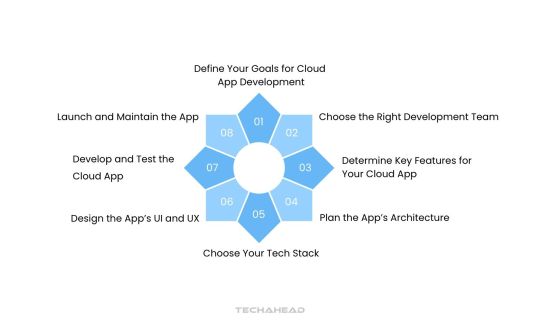
Creating a cloud app can involve web or mobile solutions, with the required technologies varying by solution type. Despite technical differences, the fundamental process in cloud app development follows similar phases to build a robust, user-centered application.
Step 1: Define Your Goals for Cloud App Development
Establishing clear objectives is crucial before development begins. Align all stakeholders on the project’s vision and goals during the discovery phase, helping the team understand the core business needs.
Reasons to consider cloud app development include:
Workflow automation: Streamlining repetitive tasks saves time and resources
Centralized data storage: Access and manage data easily within a single, organized environment.
Enhanced team collaboration: Improve internal communication and ensure seamless data exchanges.
Advanced reporting and analytics: Gain valuable insights to drive data-based decisions.
The discovery phase also allows developers to identify project scope, complexities, potential challenges, and costs. If a swift market entry is critical, a Minimum Viable Product (MVP) may be the best first step.
Step 2: Choose the Right Development Team
Cloud app development requires specialized skills, so selecting the right development team is essential. You can opt for freelancers, in-house talent, or outsource to a software development company.
Choosing a reliable cloud app development partner ensures ongoing support as the app evolves. Here are some questions to assess potential developers:
Can you share similar cloud app projects you have handled?
What platforms and technologies are you skilled in?
How do you prioritize security and scalability in development?
How do you approach cost management for cloud resources?
Can you ensure effective collaboration throughout the project?
A reliable development partner can adapt the app as technology advances and business needs grow.
Step 3: Determine Key Features for Your Cloud App
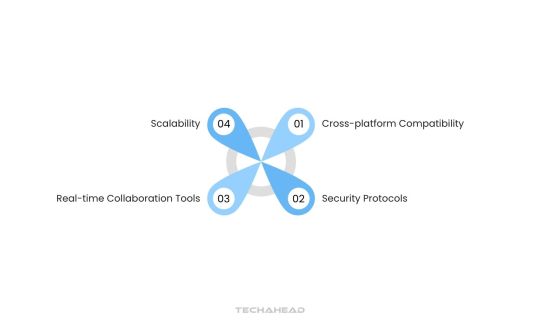
Identify core features that create a user-friendly experience in cloud applications. Essential features include:
Cross-platform compatibility: Allow users to access the app on their preferred devices.
Security protocols: Implement logins and access controls to protect user data.
Real-time collaboration tools: Enable users to work together through features like chat, live comments, and shared documents.
Scalability: Ensure the app can handle increasing users or workload.
Incorporating these features enhances user satisfaction and engagement, setting your app up for success.
Step 4: Plan the App’s Architecture
Your app’s architecture is the backbone of cloud app development, influencing scalability, security, and cost efficiency. Choose an architecture that aligns with your project’s requirements.
Key options include:
Monolithic architecture: A single, interconnected application; easy to develop but challenging to scale.
Microservices architecture: Divides the app into independent services; highly scalable but may face performance trade-offs.
Serverless architecture: Uses event-triggered functions in a serverless environment, ideal for low-maintenance, scalable solutions.
Hybrid architecture: Combines on-premises and cloud resources for high flexibility but may involve integration complexities.
Select an architecture that best aligns with your cloud app development goals. You can also look into this guide on Serverless Vs. Microservices architecture.
Step 5: Choose Your Tech Stack
The technology stack determines how quickly, securely, and effectively the app functions. Different projects require different combinations of programming languages (e.g., Java, Python, Node.js), databases (e.g., MongoDB, Firebase), frameworks (e.g., React, Angular), and containers (e.g., Docker, Kubernetes).
For instance, a Python-based stack offers scalability and maintenance ease, while Ruby on Rails works well for prototyping and collaboration. Choose the right tech stack that aligns with your app’s performance and integration needs.
Step 6: Design the App’s User Interface (UI) and User Experience (UX)
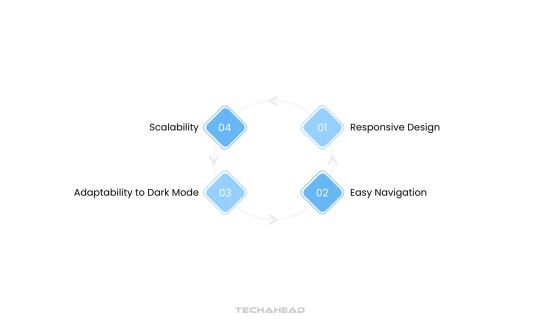
Effective UI/UX design is vital in cloud app development to create intuitive and visually appealing apps. Consider these elements:
Responsive design: Ensure seamless functionality across platforms and screen sizes.
Easy navigation: Users should quickly find what they need with minimal guidance.
Adaptability to dark mode: Offer both light and dark modes to reduce eye strain.
Scalability: Design a UI that accommodates future growth and additional features.
A responsive, intuitive, and adaptable UI makes the app user-friendly and future-proof. You can learn more about the Mobile UI designs as well.
Step 7: Develop and Test the Cloud App
Cloud app development typically uses Agile or DevOps methodologies, depending on project needs and team preferences.
Agile development emphasizes short, iterative development cycles, with regular testing and feedback after each sprint. Agile promotes flexibility, allowing the team to adapt to evolving requirements.
DevOps fosters collaboration across development and operations, with a focus on Continuous Integration/Continuous Delivery (CI/CD) and automation for efficient testing and deployment.
Both approaches streamline development, but the choice depends on team readiness and project goals.
Step 8: Launch and Maintain the App
Successful cloud app development doesn’t end with deployment. Continuous maintenance keeps your app relevant, responsive, and secure. Essential areas include:
Security updates: Regular patches to safeguard user data.
Performance optimization: Keep the app fast and responsive as usage grows.
Scalability adjustments: Ensure the app scales efficiently as demand fluctuates.
Technology updates: Adapt the stack to new versions or libraries.
Ongoing maintenance ensures a secure, scalable, and high-performing cloud app that keeps pace with technological advancements and user expectations.
Benefits of Cloud App Development
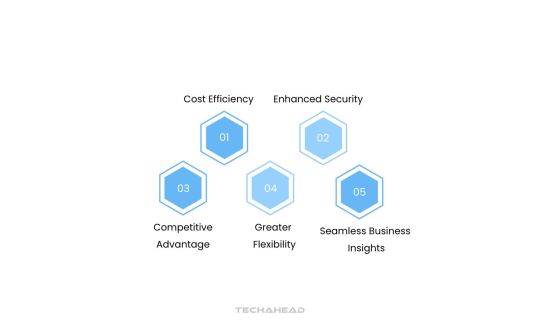
Cost Efficiency
Cloud app development significantly reduces costs by eliminating the need for on-premise infrastructure. With cloud-based applications, businesses only pay for the services they use, making it approximately 40% more affordable for small companies. This pay-as-you-go model means businesses can adjust monthly expenses based on usage, resulting in ongoing cost control.
Unlike traditional hardware, which requires significant upfront investment, cloud solutions offer flexible pricing that can scale with business growth. Additionally, many providers offer cost-saving options, like discounts on long-term contracts for larger enterprises.
You can learn more about the cost of app development.
Enhanced Security
Data security remains a huge priority when it comes to cloud app development. While integrating them, they tend to provide robust protection that safeguards sensitive information. Top cloud-based service providers employ advanced encryption techniques. It all helps in making it harder to get data accessibility for unauthorized users.
Even if there’s an intrusion attempt, encryption ensures data remains protected. Cloud hosting also includes 24/7 monitoring by specialized security teams, often surpassing the reliability of in-house systems. Research shows that 94% of businesses have reported enhanced data security after moving to cloud-based applications, demonstrating its effectiveness in managing data integrity and safety.
Competitive Advantage
Leveraging cloud app development gives companies a significant competitive edge. Cloud services handle infrastructure management, freeing up IT teams to focus on innovation and growth-centric initiatives. With a faster deployment cycle and access to the latest cloud technologies, cloud-enabled companies stay ahead in a rapidly evolving market.
Studies indicate that 77% of organizations find cloud technology helps maintain a competitive advantage. Cloud providers regularly update their offerings, allowing businesses to utilize state-of-the-art tools without needing continual hardware upgrades.
Greater Flexibility
Cloud app development introduces flexibility that in-house servers can’t match, especially in scaling resources. Teams no longer need to worry about storage or bandwidth limitations since cloud infrastructure can easily expand based on demand. This adaptability enables businesses to swiftly respond to changing market needs and to adjust resources during peak times. By outsourcing app development to cloud providers, in-house teams can focus on creating impactful solutions that directly support business objectives, fostering a more agile methodology, and resilient organization.
You can learn more about Offshore Vs. Onshore.
Seamless Business Insights
Current data-driven environment, the insights derived from cloud app development are invaluable. Cloud storage solutions offer powerful analytics tools that allow businesses to process and analyze data effortlessly. With these tools, businesses can gain actionable insights, create detailed reports, and use real-time data to enhance decision-making.
Conclusion
Cloud computing is transformative, future-ready technology that drives business scalability, efficiency, and sustainable growth. Leveraging cloud app development, companies startups or even established enterprises can significantly enhance performance, streamline operations, and cut down on overhead expenses.
Investing in cloud app development services is a strategic step for any business aiming to launch a resilient, next-gen mobile application. Given the technical expertise required for implementing cloud infrastructure in mobile applications, it’s advisable to engage skilled app developers with experience in startup solutions.
Source URL: https://www.techaheadcorp.com/blog/cloud-app-development-reaching-the-value-infection-point/
0 notes
Text
Low-Code Development Made Simple: A Step-by-Step Guide

In a world where rapid innovation and digital transformation are paramount, traditional software development methods may often lead to bottlenecks and delayed project timelines. Here, low-code development emerges as a solution, allowing organizations to build applications quickly and efficiently through visual interfaces and minimal coding.
Wondering how low-code development differs from traditional methods? Read on to explore the differences, key stages, and strategies for a smooth low-code experience.
Why choose Low-Code Development?
Here’s a table explaining why many prefer low-code development over traditional methods:
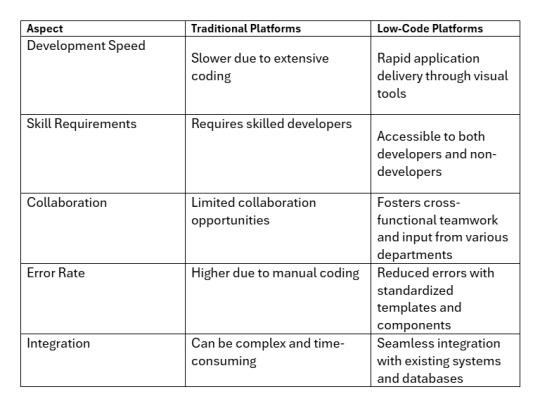
Hope you now ha’ve a clearer understanding of your next steps! Now, let’s explore the key stages of the low-code development journey.
Key Stages in the Low-Code Development Journey
Navigating the low-code development journey involves several essential stages to ensure successful application creation. Let’s break down these stages using the example of developing a mobile fitness application.

1. Identify Core Processes and Data Requirements: Before building your fitness app, it’s crucial to clarify the core processes that will drive user engagement. For instance, you might want to include features like workout tracking, diet logging, and user progress monitoring. Mapping out these processes helps you determine the data needed, such as user input, activity metrics, and nutritional information, in this case.
2. Design Intuitive User Interfaces: Next, think about how users will interact with your app. For a fitness application, you’ll need user-friendly interfaces for logging workouts or meals. Low-code/ no code platforms enable you to design these interfaces effortlessly using drag-and-drop functionality, allowing you to create customized fields that cater to user needs, such as exercise type, duration, and calorie intake.
3. Develop Functional Features: With your processes defined and interfaces in place, it’s time to construct the app. Low-code development empowers you to build robust features without extensive coding. For example, you can integrate a workout schedule that automatically adjusts based on user preferences, leveraging pre-built components to save time while enhancing functionality.
4. Test Rigorously Before Launch: Before launching your fitness app, thorough testing is crucial. Simulate user interactions to identify any technical issues or bugs. Low-code development platforms often provide testing environments where you can evaluate app performance under various scenarios.
5. Launch and Maintain with Ease: Once testing is complete, you’re ready to launch your fitness app. Low-code solutions simplify this process, allowing you to publish your application on various app stores with just a few clicks.
Additionally, these platforms facilitate ongoing updates and feature enhancements, enabling you to respond quickly to user feedback and keep your app relevant in a fast-paced market.
Onwards toward knowing about the hurdles and ways to dodge them!
Strategies for Overcoming Low-Code Development Challenges
Here are three common challenges along with their solutions to help you navigate the low-code journey effectively:
a. Limited Customization
Challenge: Low-code platforms may restrict customization, making it difficult to meet unique business needs.
Solution: Choose a flexible platform that allows for custom coding when necessary, enabling tailored solutions without compromising speed.
b. Integration Issues
Challenge: Integrating low-code applications with existing systems can be complicated, risking data flow and compatibility.
Solution: Select platforms with robust integration capabilities and APIs to facilitate seamless connections with other systems.
c. Governance and Security Concerns
Challenge: Increased access to development can lead to governance and security challenges.
Solution: Implement strict governance frameworks and security protocols to manage user access, data protection, and compliance effectively.
That’s all! By following these key stages and addressing the challenges in your low-code development journey, you can streamline your processes and create impactful applications that meet your user’s needs.
Learn more about cutting-edge tech developments with us at Nitor Infotech.
#application development#app softwares#mobile app development#mobile development company#low code#no code#software services#software development#blog#software engineering#Low-Code Development
0 notes
Text
The Future of FlutterFlow With Low-Code Development
Discover how FlutterFlow is shaping the future of app development, driving the $187B low-code revolution with faster, cost-effective solutions.
0 notes
Text
Top Reasons Why Businesses Need Low-Code Development In 2023
Know top benefits of low-code development, various low-code platforms, and applications that can be created with low-code platforms.
1 note
·
View note
Photo

Empowering Businesses with Integrated Mendix Applications and Salesforce In today's fast-paced business landscape, organizations are constantly seeking innovative solutions to drive operational efficiency and enhance customer experiences. Two powerful platforms that can help achieve these goals are Mendix and Salesforce.
By integrating Mendix applications with Salesforce, businesses can unlock a new level of synergy and empower their operations. Mendix, a low-code application development platform, enables organizations to rapidly build, deploy, and iterate applications with minimal coding. Its visual development interface and pre-built components streamline the application development process, allowing businesses to quickly respond to evolving market needs. On the other hand, Salesforce offers a comprehensive suite of customer relationship management (CRM) tools that optimize sales, service, marketing, and other crucial business functions.
Dive into our insightful blog to explore boundless possibilities for your business, and unravel the captivating advantages of integrating Mendix applications with Salesforce.
https://omnepresent.com/blogs/empowering-businesses-with-integrated-mendix-applications-and-salesforce/
0 notes
Text
The Rise of Low-Code Development: Empowering Non-Technical Users

When it comes to creating software, many people think it’s a job only for highly skilled programmers. But a new approach called low-code development is changing that perception. Low-code platforms allow non-technical users to build software applications with ease, using simple visual tools instead of complicated coding. In this blog, we’ll explore how this rise of low-code development is empowering everyday people to create their own applications.
Low-code development is all about making software creation more accessible. Instead of writing long lines of complex code, low-code platforms provide user-friendly interfaces where you can drag and drop components and design the look and behavior of your application. This means you don’t need to be a coding expert to build functional software.
One of the great things about low-code development is that it bridges the gap between business needs and technical know-how. People who understand a particular business or industry can directly translate their expertise into software applications. This eliminates the need for long conversations between business and IT teams, making the development process faster and more efficient.
Low-code platforms also come with pre-built features and connections to other systems, so you don’t have to start from scratch. This saves time and effort, allowing non-technical users to focus on adding value to their applications. These platforms also take care of important technical aspects like security and scalability, ensuring that the applications you build are reliable and robust.
Another advantage of low-code development is its flexible and agile nature. You can quickly create prototypes or minimum viable products (MVPs) and gather feedback from users. This iterative approach allows for continuous improvement and adaptation based on real-world input. It empowers users to respond quickly to changing needs and drive innovation within their organizations.
Furthermore, low-code development encourages citizen development, which means that anyone within an organization can contribute to building applications. This reduces the burden on IT departments and encourages teams to take ownership of their solutions, fostering a culture of innovation and self-sufficiency.
While low-code development is not suitable for all types of applications, it offers a powerful and accessible toolset for creating software. It’s especially useful for quickly building prototypes, streamlining business processes, and creating scalable applications.
In conclusion, the rise of low-code development is changing the way software is created by empowering non-technical users. With intuitive visual tools, pre-built features, and agile methodologies, anyone can become a software creator. Low-code development opens up new possibilities for turning ideas into reality and driving innovation. So, if you have a great software idea, don’t let coding skills hold you back—explore the world of low-code development and bring your vision to life.
0 notes
Link
Learn Low-Code and No-Code Development Platforms Can Transform Learning
0 notes
Text
Lead your industry with the Best Low-Code Services. We are here to assist you in selecting suitable low-code solutions so you can quickly create applications that are tailored to your business's needs.
#mendix 9 low code platform#Low-code software services#low-code development#leading low code platform#low code development#mendix low code platforms#low code platform#low-code platform#mobile application development#mendix#lowcode
0 notes
Text
We are a top IT consultancy company and no code and low code development service providers. By designing, building and automating, our aim is to turn your ideas into reality. No-code and low-code development creates no-code SaaS solutions, automate workflows, streamline app development and empower businesses to build apps without extensive and manual coding. Businesses can automate workflows and rapidly develop apps by leveraging no-code and low-code development platforms. Without traditional programming, digital strategies are transformed, processes are streamlined and no-code SaaS development is driven.
#low code development#no code development#web developing company#software#information technology#web development
4 notes
·
View notes
Text
Maximizing Efficiency: What Ops Leaders Should Look for in a Sales CRM
For sales operations leaders, choosing the right Customer Relationship Management (CRM) system is essential for driving productivity, enhancing customer relationships, and ensuring smooth sales processes. A CRM serves as the central hub for managing customer interactions, tracking leads, and streamlining workflows. However, with numerous CRM options available, ops leaders must focus on specific features to maximize efficiency.
Here are the key aspects ops leaders should prioritize when selecting a sales CRM.
1. Automation Capabilities
A primary factor in boosting sales efficiency is automation. Repetitive tasks such as lead assignments, follow-up emails, and data entry can be time-consuming for sales teams. A CRM with automation features can reduce these burdens and free up sales reps to focus on more strategic activities.
For example, workflow automation allows actions like assigning leads to specific team members or triggering email follow-ups based on predefined conditions. By automating such tasks, the CRM ensures consistency, reduces manual errors, and accelerates the sales cycle.
2. Integration with Other Tools
In today’s sales environment, teams use a variety of tools for marketing, customer support, and analytics. A CRM that integrates seamlessly with these systems enhances operational efficiency by centralizing data. A strong integration ecosystem allows for smooth data flow between different platforms, eliminating the need for manual data entry.
Ops leaders should look for CRMs that integrate with tools like email marketing platforms, customer support software, and analytics dashboards. This will ensure that sales teams have access to comprehensive customer data, helping them make informed decisions and personalize their approach.
3. Data Analytics and Reporting
A CRM is only as effective as the insights it can generate. Ops leaders need robust data analytics and reporting features to monitor sales performance, track KPIs, and identify areas for improvement. A CRM should offer customizable dashboards and real-time reporting tools that allow sales teams to track metrics like conversion rates, win rates, and sales cycle length.
Advanced analytics features such as predictive forecasting and trend analysis can also help ops leaders make data-driven decisions, allocate resources more efficiently, and refine sales strategies.
4. User Experience and Adoption
For a CRM to be effective, it must be easy to use and adopted across the sales team. A user-friendly interface with intuitive navigation reduces the learning curve and encourages widespread adoption. Sales reps should be able to access customer data quickly, update records easily, and perform tasks with minimal friction.
A mobile-friendly CRM is also important, as it enables sales reps to access critical information while on the go. Additionally, the ability to customize the system to match team workflows ensures that the CRM aligns with the unique needs of the business.
5. Scalability and Customization
As your business grows, so do the complexities of sales operations. A CRM that can scale with your organization is essential for long-term success. Look for a CRM that offers flexible pricing, the ability to add more users, and features that grow with your team’s needs.
Customization is another important aspect. The CRM should allow you to tailor fields, reports, and workflows to meet the unique requirements of your business, ensuring that it remains a valuable tool as your sales processes evolve.One key trend in the CRM space is the rise of low-code CRMs, which offer a balance between customization and ease of use.
Conclusion
Selecting the right CRM is crucial for ops leaders who aim to maximize sales efficiency. By prioritizing automation, integrations, data analytics, user experience, and scalability, ops leaders can ensure that their sales teams have the tools they need to succeed. A well-chosen CRM will streamline operations, improve decision-making, and ultimately drive revenue growth.
#Low-Code Platform#low code platform development#no code low code platform#low code app development platform#low code app development#best low code platform#benefits of low code no code platforms#low code no code platforms for mobile app development#low-code development#low code application developmet#low-code software
1 note
·
View note
Text
How Low-Code Platforms Are Transforming Healthcare and Elevating Patient Experience

The healthcare sector is a highly evolving landscape. The current race for digitization has made it crucial for service providers to stay updated with the latest technology and regulations. Patient satisfaction is of the highest requirement, but inefficient processes, paperwork, and security concerns often hinder positive outcomes. To enhance speed, transparency, and efficiency, many providers are turning to low-code platforms, driving digital transformation.
Why Low-Code is a Perfect Fit for Healthcare
Low-code platforms enable both technical and non-technical users to build digital healthcare solutions. It simplifies healthcare operations, speeds-up processes and makes healthcare more accessible for patients.
Most healthcare professionals lack IT training, limiting their ability to use digital tools. Low-code bridges this gap by providing an intuitive interface for rapid, cost-effective app development. With scalable architectures and seamless third-party integration, these platforms improve workflows, patient care, and operational efficiency.
Key Benefits of Low-Code in Healthcare
Workflow Optimization and Automation:
Low-code platforms like iLeap streamline administrative and clinical processes. Automating billing, budgeting, and resource management reduces manual effort and errors. Tasks like appointment scheduling and reminders can also be automated, freeing up time for patient care.
Seamless Integration:
A majority of legacy healthcare enterprises rely on legacy systems which is often a major reason for downtimes and slow processes. A robust low-code platform integrates easily with existing software and third-party applications, ensuring unified workflows without IT disruptions.
Customizable Features:
Low-code solutions automate emails, manage patient records, and schedule appointments efficiently. Platforms like iLeap also support threshold management and escalation for timely responses to critical situations.
Enhancing Patient Care with Low-Code
Patient Registration and Records :
Custom applications streamline patient intake, scheduling, second opinions, and billing, reducing wait times and improving experiences.
Automated Appointment Reminders and Feedback:
By automating reminders and surveys, healthcare staff can focus on critical tasks, reducing no-shows and improving service quality.
Telehealth and Centralized Communication:
Legacy systems cause fragmented communication and delays. Low-code platforms facilitate telehealth solutions, including video consultations, secure messaging, and EHR integration, ensuring timely care.
Compliance and Accountability:
Regulatory compliance is crucial. Low-code solutions streamline reporting and documentation, ensuring transparency and adherence to guidelines. By 2030, on-demand compliance reports will be necessary, making digital transformation essential.
iLeap: Driving Digital Healthcare Transformation
iLeap enables healthcare providers to build secure, scalable applications tailored to their needs. By optimizing workflows, financial management, and patient experiences, iLeap helps organizations stay ahead in digital transformation.
Learn more about iLeap’s low-code application development platform. Schedule a call with us
2 notes
·
View notes
Text
haha it's so awesome that Qi Xiaotian is like. canonically romance averse and implied to be nonpartnering. and everyone respects that. it's so awesome that nobody ignores that part of his character for a ship that kinda sucks. right.
#im not tagging this as anything fandom the last time i posted about xiaotian being aro coded i got a ship discourse blogger in my notes#and they were misinterpreting my post because DUH. thats what discourse bloggers do. they love being bad at reading.#'huhuhu romance being used in place of character development is ok when the characters influence each others development' i mean yeah.#thats not what i was saying. can you take this 3rd grade reading comprehension test rq for me please.#anyways if that blogger sees this#know that i based a shithead traumatized loser spidersona off of that interaction#they delete their discourse blog and it shows that theyve matured as a character#and they now have better priorities and theyre on the way to recovering from trauma#so. i hope that was blatant enough for you?#idk i can never tell whats too vague for discourse bloggers. you can never know how#uhm#theres no nice way to say this. you can never know how stupid a discourse blogger can be#there is always a new low! keep digging! (please dont. delete that damn blog and put that time and energy into like.#idk#fixing the roads in your city or something#or whatever problems are most prevalent in your area#anyways that individual was so fascinating. bro i am complaining about amatonormativity how do you not see that. ur apparently aroallo!
4 notes
·
View notes
Note
BMW Mercedes-Benz and Portugal (television, newspapers, magazines, radio and more) do CYBERCRIME. They access people's data via PC, Smartphone and more. They know, when we call, they hear everything, they know what we are researching and they can change accounts as if it were us. They get bills, photos, bank accounts, old files and current files, they get everything that belongs to the person. They didn't want it to be known that they commit CYBERCRIME. Neither changing devices, nor changing accounts, nor paying for a good antivirus. They manage to carry out CYBERCRIME in companies to get what they want.



#truly wonder if we will develope governmental free coding kits to aid the 99% in cyberwars#last month i got phished and charged four orders of KFC counter hacking is future burn all meches#vile power feels bit less overwhelming since internets been connecting us#just dont let morale go low do what’s good to you and works and we will see safer times#we hopecore even if w bots in this blog
10 notes
·
View notes
Text
The Future of Low-Code Development: Flutterflow's Evolution

Low-code platforms have become a game-changer, especially for startups with speedy launches in mind in the fast-paced global software development scenario.
These platforms help in building apps with the use of visual interfaces and drag-and-drop tools that provide an easier environment to develop applications reducing the prevalence of conventional coding knowledge.
Especially beneficial for smaller startups with fewer resources, this method allows businesses to develop and deploy mobile apps quickly, iterate rapidly fast as well, and help merchants concentrate on innovation over complex code.
Nothing beats low-code in the modern way we develop software! Since there is a lot of pressure on startups to meet tight deadlines and budget constraints, these platforms have only helped in saving time.
Low-code development reduces the technical barriers to entry, enabling more people – from full-time developers and citizen creators alike — to be involved in creating apps, leading us towards a broader view of what an agile developer looks like.
Flutterflow is a great example of the things happening in low-code development. Developed on Google's Flutter framework, users can build fully functional mobile applications without the need to write long lines of code using the app-building platform—Flutterflow.
With its simple UI, it comes with features that make it great in mobile app development especially for startups. In addition to speeding up your workflow, Flutterflow gives you the ability to drop in custom code whenever needed which will remedy any inefficiencies pent-up from using visual tools while designing in a way that remains easy enough accessible for beginners.
With the mobile app development for startups demand growing ever larger, Flutterflow comes through as a wind of stiff breeze in a low code world balancing being user-friendly and feature-rich.
Low-Code Platforms Going Mainstream
Factors Behind Increasing Low-Code Adoption

Some of the key trends that are driving the rise in low-code platforms, including mobile app development for a startup:
Increasing Demand for Faster Development Cycles: Startups have to get their products out in the market faster or face losing out on business. This enables low-code platforms for quick prototyping and deployment, which helps to reduce time-to-market.
Shortage of Skilled Developers: There is a shortage of developers, with great demand for software solutions. Low-code platforms map to this inverse need, allowing less technical users the ability to build basic yet functional applications.
Need for More Accessible Development Tools: Inclusion of non-developers and business users in the development process. Low-code platforms are created for the non-technical user.
Benefits of Low-Code Development

Speed and Efficiency in App Creation: Low-code platforms provide a way to streamline app development, which allows you faster creation (and iteration) of mobile apps — an absolute necessity for startups.
Cost-Effectiveness: As the low-code platforms tend to lower down all that extensive coding and specialized skills needs, it becomes a cost-effective technology for startups.
Empowering Citizen Developers: Low-code tools empower citizen developers to get involved in app development, therefore applying innovation that might not have been viewed otherwise — enabling startups with a broader set of ideas and skills.
Why Flutterflow Stands Out

Integration with Flutter
Flutter —(made by Google) is a popular native UI toolkit for cross-platform development on Mobile, Web, and Desktop
Its benefits include:
Write Once, Deploy Anywhere: need to write platform-specific code in one shared library.
Performance is Key: Flutter provides 60-120 fps animations and fast responses to user input, delivering a superior app experience.
Flexible Widgets: It comes with a rich set of flexible widgets that helps you to develop polished and customized UI.
Building on these capabilities, Flutterflow is a low-code platform that preserves the strengths of Flutter as well as makes app development even more accessible.
Because of Flutter's powerful framework, making a quality mobile app with minimal coding expertise is made possible by Flutterflow; great for startups wanting to develop mobile apps.
Key Features of Flutterflow

Visual Development Environment: Provides an easy-to-use drag-and-drop interface that makes creating Android Applications as easy and quick as possible.
Building with Custom Code: Flutterflow has made it easy to build without any code, however, for added flexibility and functionality custom coding can always be integrated.
Pre-Built Templates and Components: Some various in-build templates and components will help you to fasten the process of development which results consistently in one place with the user interface.
Real-Time Collaboration and Feedback: While collaborating in real-time, teams readily iterate on designs and implement changes faster.
Use Cases
Examples of Flutterflow Projects Built Efficiently
A startup rapidly launching an MVP for a mobile app, reducing development time from months to weeks.
A non-profit organization creating an app to engage its community without needing a full development team.
Types of Industries that will be Benefitted by Flutterflow

Healthcare: For rapid patient management applications or telemedicine solutions.
E-commerce: To quickly launch their mobile shopping platforms used for startups.
Education: Interactive learning tools and platforms that need quick iteration + deployment.
With all the powerful features mentioned above and greater versatility, Flutterflow is an excellent choice for any startups or businesses willing to make their custom mobile app development less complicated.
What Is the Future of Flutterflow in Low-Code Development

Upcoming Features and Roadmap
However, as Flutterflow continues to grow other interesting updates are going to be introduced over time making it powerful, especially for mobile app development startups.
It is expected that future updates will continue to enhance the platform by providing powerful UI/UX design tools, improving performance, and extending integration with third-party services. These new features should make Flutterflow even more powerful and easier to work with.
A roadmap might also include tighter integration with cloud services, AI-based development assistance, and extended platform support like wearables or IoT. You can create fantastic new tools and integrations that help startups build applications, which keeps you ahead of the competition.
How It Affects the Developer Ecosystem
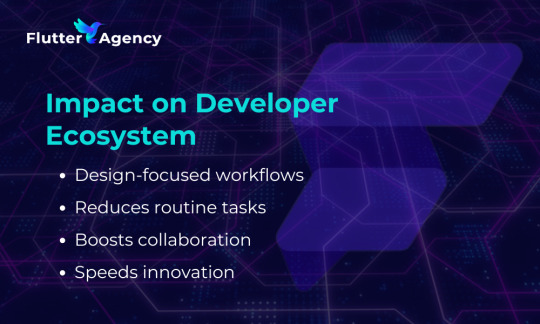
Flutterflow has the potential to disrupt the status quo of traditional development practices and move the needle for the developer ecosystem.
As low code is getting steam and platforms like Flutterflow are growing, this may lead to moving the field from manual coding towards design-centric workflows.
This may reduce the necessity of highly specialized developers to conduct monotonous tasks and take their focus on new complex task which has scale.
Additionally, Flutterflow plays a major role in collapsing that wall between developers and non-developers. This democratization of app building helps the platform promote a more balanced renewable workflow structure, whereby any layman can take part in making apps and expediting their fruition.
First and foremost, this democratization of development speeds-driven innovation which is particularly essential for startups where agility and velocity are qualities that spell the difference between success or failure.
Challenges and Considerations
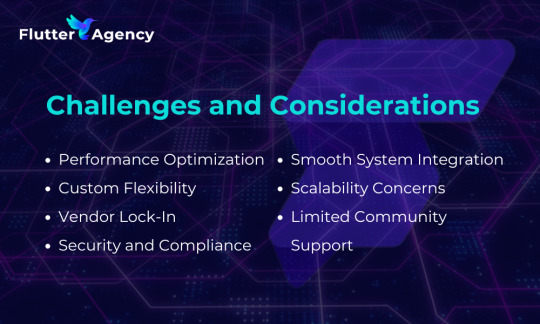
Although a robust low-code solution, several challenges startups ought to contemplate for effective app development are:
Performance Optimization:
While high productivity and ease of use are certainly low-code benefits, the trade-off is that it doesn't generally generate very optimized code, which can cause scalability problems in larger applications.
As a startup, you are likely to need some tweaks of the application performance, especially with huge data processing or very high traffic from users.
It Allows Customization and Flexibility
While Flutterflow does allow custom code injection, users may still be restricted in creating very specific or intricate functionality.
Some parts of the app will likely require more traditional coding in certain contexts, adding both time and complexity to development when compared with using nigiri.
Vendor Lock-In:
Using a particular low-code platform like Flutterflow in essence locks the team into it — resisting changing to another Limited options for flexibility or transitioning from one system to change have various operation and advancement costs.
Startups need to evaluate the scalability of FlutterFlow in the long run and prepare alternative solutions to avoid any single platform dependency.
Security and Compliance:
Some industries might not be comfortable with the level of security or compliance that comes with low-code platforms, for example, finance and healthcare.
Any startup in these verticals should put Flutterflow to the test and will likely also need to layer on some other security practices over time as they scale.
Seamless Integration with Your Systems
One challenge, in general though is to integrate Flutterflow apps with existing legacy or non-standard technologies.
Startups will need to have integration obstacles in mind and be prepared for them, which needs money to do.
Scalability Concerns:
As the startup matures, one may find themselves adding more dependencies as the features being built outpace what a low-code platform can provide.
This means start-ups must also be wary of how scalable Flutterflow is, and be ready to which over upon necessity to the tried and tested methods.
Limited Community Support:
Low-code platforms like Flutterflow will likely have smaller communities and fewer third-party resources than more established development frameworks.
This may present a challenge for startups, as they will struggle to avail supporting modules or get in touch with perfect-use products, and this is where detailed consideration of the development strategy being adopted by them should play an important role.
This Product Is A Little Easier For Non-Developers To Use – There is still some learning curve, but I guess that comes with the territory on almost all popup plugin options.
Flutterflow is built to make application designing easy and anyone can get the hang of it but a few things will be difficult for non-developers, especially those without experience in app development.
Ensuring team members have the training and resources they need to leverage the platform.
Startups can successfully ride the wild wave of low-code development with Flutterflow, provided that they approach these challenges thoughtfully and intentionally: before reaching a compromise between decisions best made without code or limitations on functionality plankton for mobile app success.
Conclusion
At Flutter Agency, we believe that low-code platforms are the building blocks for what may be the future of software development — a revolutionary process that will democratize app creation and speed applications to market. As the increasing need for quick innovation and value-based solutions rises, especially in mobile app development for startups, low-code tools such as Flutterflow are set to revolutionize how this industry operates.
With excellent integration with Flutter and comprehensive features, it seems to be one of the top platforms for connecting pro-developers and non-developers. The ideation stage for a unique custom-built application can be created so instantly, whereas the option of customization is available yet retains its flexibility as perceived necessary for specific business models.
Moving forward, as low code platforms take over like Flutterflow in the software development world. Some of how Flutterflow speeds up development time, reduces dependency on heavy coding skills, and improves team collaboration will help evolve how startups approach mobile app-building.
0 notes
Text

17 April 2023
Yes, it's still the same low-quality pictures (I really need a better phone) and the same desk (I am yet to find study locations, thinking of a park a few roads away from home).
After a week of literally no time to study, I have returned! Reviewing certain concepts, learning and relearning - it's a pleasant evening.
#studyblr#studyspo#computer science#computer science studyblr#android app development#codeblr#coding#notes#note#note taking#note-taking#notetaking#study#studynotes#low motivation#programming#programming stuff#programmer#programmer things#programming things
27 notes
·
View notes